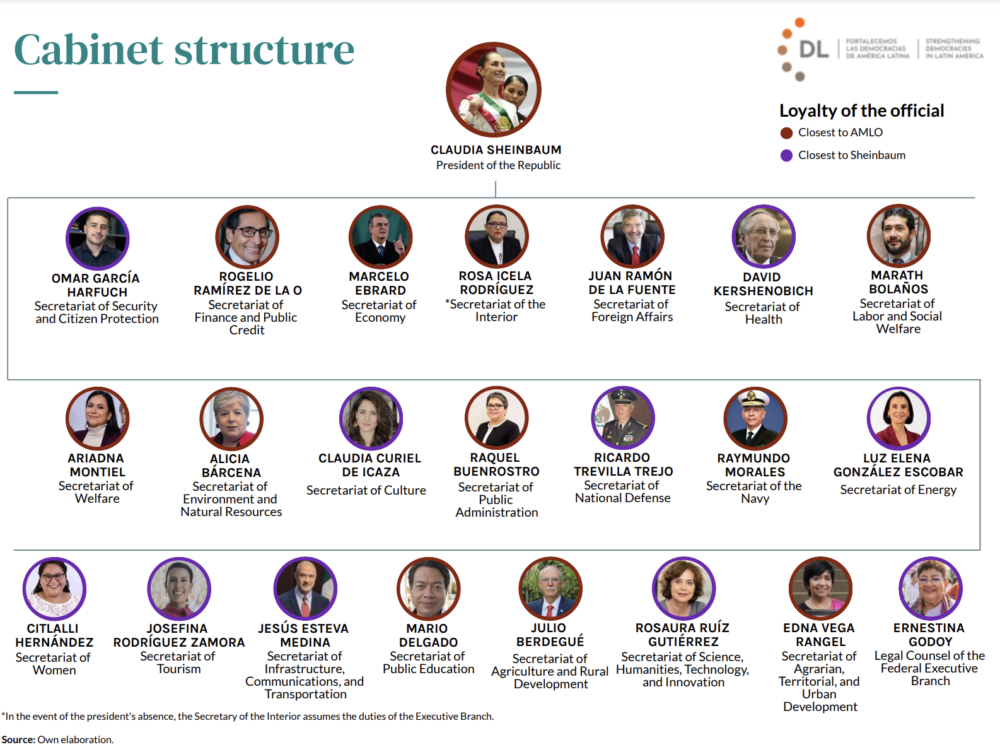The “Second Floor” of the FourthTransformation: Key Figures in ClaudiaSheinbaum’s New Administration

On October 1st, Claudia Sheinbaum took office as president for the 2024-2030 term, after winning the June 2nd election with 59.75% of the votes. In her inaugural speech, she emphasized the continuation of the Fourth Transformation initiated by Andrés Manuel López Obrador (AMLO), focusing on republican austerity, promoting public infraestructure developments, attracting investments to boost nearshoring, and strengthening trade relations.
To achieve her goals, she introduced the cabinet that will support her in building the “Second Floor” of the Fourth Transformation. The Executive Branch will consist of 21 government secretariats, filled by officials from both AMLO’s administration and her own government in Mexico City. The cabinet members were selected based on their technical and professional backgrounds.
Who are the key players in this new power structure?
To answer this, we provide an in-depth look at the new cabinet. We also assess the cabinet members’ ties to the two leading figures of MORENA: the current president and former president AMLO, to better understand the underlying alignments and loyalties within the cabinet.
We also explore the balance of power in Congress, a crucial element for advancing the government’s legislative agenda. This includes passing the constitutional amendments proposed by AMLO before his departure, as well as future reforms that Sheinbaum is expected to pursue during her term.


The ruling party’s “Aplanadora” in the Chamber of Deputies
The Sheinbaum administration starts its term by tackling key issues left by her predecessor, Andrés Manuel López Obrador (AMLO), particularly the pending discussion of several constitutional amendments that he could not pass due to a lack of congressional support. The main objective of the electoral campaign was to secure a supermajority (two-thirds) in both chambers, enabling the approval of these amendments without opposition interference (PAN, PRI, MC). Today, those numbers are within reach in the Chamber of Deputies, where the ruling coalition (MORENA, PVEM, and PT) controls 364 of the 500 seats. This gives the government a comfortable margin over the 334 votes required to approve constitutional amendments.
The ruling majority in the Chamber has earned the nickname “Aplanadora” for its ability to prevent opposition parties from blocking legislative initiatives.
The opposition faces even greater institutional challenges. With less than 33% of the seats in the Chamber (currently 27.2%), it cannot file legal challenges with the Supreme Court to review the constitutionality of an amendment. The same applies in the Senate. Previously, using this mechanism, the opposition succeeded in overturning proposals such as AMLO’s energy and electoral reforms.
Key constitutional amendments already passed by Congress include the reform of the Judicial Branch and the transfer of operational and administrative control of the National Guard to the Secretariat of National Defense. By the end of 2024, Congress is expected to debate the elimination of the Federal Economic Competition Commission (COFECE, in Spanish) and the Federal Telecommunications Institute (IFT, in Spanish).
The Senate: Morena’s limit?
Although the outlook appears favorable for the ruling party, the Senate poses a potential obstacle. To reach a qualified majority, 86 out of 128 seats are required. Initially, Morena and its allies secured 83, falling three senators short. The recent loss of legal status by the Partido de la Revolución Democrática (PRD), following its failure to reach the 3% threshold in the national vote, left its senators without party affiliation. Two of them joined Morena, bringing the coalition to 85, just one vote away from the qualified majority.
Has the opposition succeeded in blocking Morena from gaining that final vote? No. The ruling party gained the support of Senator Miguel Ángel Yunes Márquez (PAN – opposition) for both the judicial and National Guard reforms. While Yunes claims he backed the proposals after reviewing them and finding them viable, speculation suggests his decision may have been influenced by a desire to halt a series of judicial investigations against him and his family in Veracruz, where the governor is aligned with the ruling party. Nonetheless, the governor has publicly clashed with the Yunes family.
